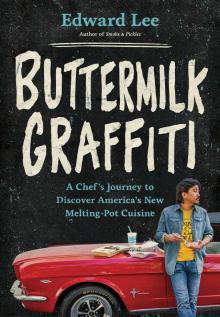- Home
- Edward Lee
Buttermilk Graffiti Page 3
Buttermilk Graffiti Read online
Page 3
Almost all the waitstaff at Café du Monde are from Vietnam. It is one of those unexpected intersections of history and culture that you find everywhere in New Orleans. The Vietnamese have been in New Orleans a long time, ever since the end of the Vietnam War. I watch them hustle around the tables, taking orders and making coffee. They’ve been working here for as long as most locals can remember. Rumor has it that their predominance at Café du Monde began with one waitress almost forty years ago. She still works here, one of the younger waitresses tells me, pointing out a tiny woman with white hair and pink lipstick. The older woman’s white uniform is too large on her. She is too busy to talk to me, and her English isn’t so good anyway, the younger waitress tells me. I ask her what the older waitress’s name is. She tells me “Annie,” but somehow I don’t believe her. She asks me if I’m waiting for beignets.
“Yes. I’d rather not wait on line.”
“Okay. Wait here for one minute.” After two minutes, the young woman returns with a large bag of beignets. I ask her how much. She doesn’t answer; just gives me a wink. I hand her a twenty-dollar bill, and she thanks me and darts off back inside. She doesn’t return. I walk down Decatur Street shoving warm fried dough into my mouth.
There is only one place in New Orleans that I know of that makes calas, and they are dense and uncompromising. I go there after I’m done with my delicate beignets, to see if the calas have changed. I sit down in a small, dark grotto, and my waitress brings me a plate of dark, heavy fried dough balls. Their calas are made from cooked rice, not rice flour, and they’re not very appetizing.
I think about the history of Asian desserts, where rice flour was the backbone of all sweets before the introduction of wheat flour in Asia. The Korean hoedduck is basically a rice flour doughnut, a denser version of a beignet, but still delicious. It is topped with granulated sugar and eaten hot. You can find hoedduck in street markets all over Seoul. They are as unrefined as they are delicious.
I can’t finish the calas on my plate. I wonder if the historic calas has more in common with the Korean hoedduck than it does with this ill-conceived ball of fried rice pudding.
Modern Korean desserts have followed the Japanese love for cakes and pastries made in the European tradition. All over Korea and Japan, you can find tiramisu, cheesecake, Swiss rolls, and sweet custards. These desserts are all made with refined wheat flour and superfine sugar, two ingredients not native to these cultures. But then, in a curious culinary twist, in both Japan and Korea, bakers will dust green tea powder over everything sweet. Also known as matcha, the powder is the most highly prized expression of green tea. Ancient and mystical, the process of making matcha involves picking the best tea leaves grown in shade. The leaves are steamed to preserve their color and flavor, then dried out under the sun and ground into a fine powder. The powder is ritualistically whisked with hot water that never quite reaches its boiling point. In the eleventh century, the Zen priest Esai wrote an entire book devoted to tea, and since then, Japan has cultivated a modern tea culture that borders on fetishism.
I don’t remember when I fell in love with matcha, but it was always a treat for me as a kid. It started with green tea ice cream, then green tea mochi, green tea cakes and custards. I dust matcha on everything, from chess pie to Nutter Butter cookies. (If you haven’t tried this before, you don’t know what you’re missing.) And over the years, I’ve watched green tea powder go from obscure Japanese ingredient to trendy must-have item for chefs and home cooks. I love what it does to sweet desserts, especially when the delicate matcha powder is dusted over something as humble and imperfect as a beignet.
After college, I quit the job at the diner. I was living on Avenue C, in New York City’s East Village, and my girlfriend at the time was a society girl from Japan. She taught me a lot about Japanese food. It seems so puerile to say that I could learn an entire culture’s cuisine because I lived with a Japanese girl, but there’s a lot to be said for spending a year with someone who loves food as much as you do. She introduced me to all the Japanese pastry shops in Manhattan. She taught me how to make a cup of matcha tea the proper way.
We lived together in a railroad apartment with a small garden, and we were happy for a while. Then one day, she confessed to me that she wanted to get married so she could stay in America. I didn’t marry her. Instead, with some credit cards and a loan from a friend, I opened my own restaurant. After that, our relationship devolved into a flurry of negative Post-it notes left on the refrigerator door. I started coming home at 3:00 a.m. smelling of pork and beer and someone else’s perfume. I was the unrefined one in the relationship.
I already knew that her father was a famous writer in Japan, and that she was well off. Then I found out that she wasn’t just wealthy; her family was worth a fortune. In other words, she was matcha, and I was a piece of shapeless dough. This made me pull away from her even more. We were too different. She ate her instant ramen with nori and shiitake mushrooms and salmon roe. I ate mine with saltine crackers and mayonnaise. I always found her naïve for thinking we could work things out. I’m sure Brandi must have thought the same about me years before. What would saying good-bye to me have accomplished? We would never have remained friends. Some worlds are just too far apart.
Not so with food. Food can be a bridge, and the best, most thrilling dishes can result from joining two different worlds. I have been making some version of this beignet for as long as I can remember. My version is light and fluffy and savory. I always add fruit to it. In winter, it can be Anjou pears; in summer, try ripe apricots or peaches. I drizzle the beignets with a little sweetened condensed milk thinned out with yuzu (a sour, tart citrus fruit). You might think I’m overdoing it, but sometimes, on a rare occasion, I’ll even put a little Nutella on the plate first. And of course, the beignet is always dusted with matcha.
This dessert is elegance colliding with simplicity. Unlike my relationship with that Japanese woman, its various, disparate ingredients work beautifully together on the plate. It works in a way that rarely works between me and the women I have known.
Korean Doughnuts
(Hoedduck)
The Korean doughnut and the New Orleans beignet are distant cousins with the same purpose—to put a smile on your face. The dough for these doughnuts contains a lot of rice flour, which gives them a crispier crust than the typical American doughnut. The filling is different, too. The cashew nuts are savory, and the sesame seeds add a bitterness to the semisweet filling. In Seoul, you can walk through neighborhoods on a brisk autumn night and see street vendors selling hoedduck. These are panfried, and they are best eaten right out of the pan while still warm and crisp.
Makes 12 doughnuts
dough
2 cups warm water (about 112°F)
¼ cup plus 3 tablespoons granulated sugar
4 teaspoons active dry yeast
2 teaspoons kosher salt
2 tablespoons vegetable oil
3¼ cups all-purpose flour, plus more for kneading the dough
1¼ cups rice flour
filling
1 cup chopped cashews
5 tablespoons dark brown sugar
¼ cup black sesame seeds
½ teaspoon freshly ground black pepper
1 teaspoon ground cinnamon
5 tablespoons unsalted butter, softened
6 tablespoons vegetable oil
¼ cup honey
To make the dough: In a medium bowl, combine the water, cup of the granulated sugar, the yeast, salt, and vegetable oil and stir well. Let stand for 10 minutes, or until foamy.
Sift together both flours and the remaining 3 tablespoons granulated sugar into a large bowl. Add the yeast mixture and mix with a rubber spatula or wooden spoon until well combined. Cover the bowl with plastic wrap and let the dough rise in a warm place for 1 hour, or until doubled in size.
Transfer the dough to a
floured work surface. The dough will be very wet, and that is okay. Dust it with just enough flour so that you can handle it without it sticking to your fingers. Divide the dough into 12 equal pieces and shape them into balls. Transfer to a baking sheet lightly dusted with flour. Set aside while you make the filling.
To make the filling: In a medium bowl, combine the cashews, brown sugar, sesame seeds, pepper, and cinnamon and mix well. Add the butter and work it gently into the mixture with a fork until incorporated.
Flour your hands, take one ball of dough, and flatten it gently with your hand. Place about 2 tablespoons of the filling in the center of the dough and fold the edges over to enclose the filling. Seal the seams by gently pressing on them with your fingers and set the doughnut seam-side down on the baking sheet. Repeat with the remaining dough and filling, reflouring your hands as necessary so the dough doesn’t stick to them.
Line a wire rack with paper towels. Heat a large nonstick skillet over medium heat, then add 1 tablespoon of the vegetable oil and heat until hot. Put one doughnut into the pan and cook for 2 minutes, or until nicely browned. Flip with a spatula and cook on the other side for 2 minutes, gently flattening the doughnut with the back of your spatula. Flip once more and cook for another minute or so, until the top is nicely browned. Remove from the pan and place on the paper towel–lined rack. Repeat with the remaining doughnuts, adding more oil to the pan as necessary. Drizzle lightly with the honey and serve warm.
Green Tea Beignets
Typically beignets are garnished with nothing more than powdered sugar, but I add a little green tea powder to the sugar for a refined bitterness and put some matcha in the dough as well. These beignets are pillowy and light, and I love how the bitter green tea powder cuts through the sweetness of the dough. Matcha comes in many different grades. You need only a little powder for the recipe, so make sure to use a high-quality one.
This recipe makes a lot of beignets. It is possible to cut it in half, but I don’t recommend it. The rise seems to suffer in a smaller batch of dough. Instead, make the full recipe and invite a bunch of friends over to enjoy the beignets with you.
Makes 30 beignets
⅓ cup warm whole milk (about 112°F)
¾ cup buttermilk
3 tablespoons sugar
4 teaspoons instant yeast
5 cups bread flour
½ teaspoon baking soda
¾ teaspoon kosher salt
1½ teaspoons matcha (green tea powder)
About 4 cups canola oil, for deep-frying
garnish
1 ripe pear, peeled, cored, and thinly sliced
1⅛ cups slivered almonds
2 tablespoons sweetened condensed milk
2 teaspoons matcha (green tea powder)
1 tablespoon confectioners’ sugar
In a small bowl, combine the warm milk, buttermilk, and sugar. Add the yeast, stir, and let stand for 10 minutes, or until foamy.
In a large bowl, combine the flour, baking soda, salt, and matcha.
Add the yeast mixture to the flour mixture and mix until a smooth dough forms. Transfer to a lightly oiled large bowl, cover with plastic wrap, and let rise in a warm place for 2 to 3 hours, or until doubled in size.
Transfer the dough to a lightly floured work surface. Use a rolling pin to roll it out to about a ½-inch thickness. Cut the dough into rectangles about 1 inch by 2 inches. Transfer the pieces to two baking sheets, spacing them 1 inch apart, and refrigerate for 30 minutes.
Heat the oil to 350°F in a small pot. Fry the beignets a few at a time until golden brown on all sides and puffed up in the middle, 2 to 3 minutes. Drain on a paper towel–lined plate.
Arrange the beignets on a large plate and scatter the plate with the sliced pears and slivered almonds. Drizzle with the condensed milk. Finish by dusting the matcha and confectioners’ sugar over the beignets. Use more confectioners’ sugar than matcha. Serve while they are still warm.
Chapter 2
The Pugilist and the Cook
The first clue a boxer is going down is in his legs. He gets flat-footed, and his feet start to drag. His balance is off. He isn’t quick enough to evade a punch that shouldn’t even have gotten close. He is vulnerable but tries to hide it. He throws out a few halfhearted jabs to show he’s still in this fight. Boxing is as much about bluffing as it is about technique. When a boxer loses the vigor to execute his footwork, you can bet his brain is turning to soup. His hands are not far behind. He forgets to protect his chin. In his torpor, he lowers his guard. A punch lands square in the jaw, and the fight is over. Boxing may be a sport of fists, but it’s the footwork that telegraphs a fighter’s skill, conditioning, and state of mind. But who wants to write a story about footwork? It’s not epic. It’s not sexy. Just keep telling us about a boxer’s deadly right hook.
Understanding boxing is the first step toward knowing Lowell, Massachusetts. The last time I was here, I spent an evening at Irish Jack Brady’s bar, the Gaelic Club, listening to Brady relive his days in the ring. One of the many great fighters Lowell has produced, Jack Brady is revered here as a local legend. Every bar patron bids him good night as he or she leaves. While I was there, more than a few people went out of their way to tell me that he was the best in Lowell.
The best at what? I asked.
Just the best man you’ll ever meet.
I’m hoping to meet up with Jack again tonight. I’ve left several messages at the bar to tell him I’m on the way, but there’s been no return call. I hop into my rented Chevy and beeline it out of Boston before the end-of-day traffic jams. I go to Lowell every time I’m in the area. It’s about an hour northwest of Boston, if the traffic isn’t too bad. There isn’t much to see once you arrive. It’s telling that when you meet the locals, their first question is “Whaddaya doing in town?,” said in a tone not menacing but bewildered. Lowell is the fourth-largest city in Massachusetts, an old mill town, with lots of factories, lots of sturdy brick buildings. It’s a town that is proudly Irish and Italian and Polish, a town of tough old men and even tougher old women. Lowell is where they filmed The Fighter, a movie about the lives of two Irish American half brothers and professional boxers, Micky Ward and Dicky Eklund, the latter known affectionately as “the Pride of Lowell.”
Ramalho’s West End Gym, where the real-life brothers trained (and where part of the movie was filmed), is still there. It is an old-school gym with creaky wooden floors and, taped to the office walls, black-and-white photos telling the story of Lowell’s rich boxing history. I’m a hopeless romantic for places like this.
I live in Louisville, Kentucky, the city that produced Muhammad Ali, though I am too young to have ever watched him fight. Still, I grew up during a golden age of showmanship boxing: Sugar Ray Leonard, Thomas Hearns, and the Marvelous Marvin Hagler. I remember a time when Gleason’s Gym in Brooklyn was the center of the boxing world. When I stand inside Ramalho’s, it reminds me of that time. I drink in the sound of punching bags in vibration and the sharp squeak of footwork on a mat. I breathe in the aroma of bruised leather and decades of sweat. The nostalgia in here is contagious, even if it isn’t mine. It gives me the chills. A massive Irish flag hangs on one wall, but the kids training here these days are mostly African American and Latino. Boxing is a blood sport that calls to the most desperate young men. Most of the Irish American kids have moved on or moved out of Lowell, but the old-timers are still here, still running the gym, still watching over their town.
Most nights, you can find Jack Brady at the Gaelic Club. I ring the doorbell and wait for a buzzer to let me in. Jack is at the bar wearing a clean white button-down shirt and a green cap with an Irish flag embroidered on it. For five dollars, you can join the Gaelic Club, a privilege that comes complete with a membership card on green cardstock. Because the Gaelic is a private club, you can do whatever you want in here. You can smoke, you can be bawdy, you can play wh
atever the fuck Irish music you want, and no one’s gonna say shit. Just don’t break any of Jack Brady’s rules. He presides over his bar, whose back wall is lined with black-and-white photos of him as a fighter. “That’s my daughter who put up these pictures,” he insists. “Me? I couldn’t give a fuck about ’em. I haven’t watched a fight since I quit the ring.”
Jack Brady wasn’t the greatest that Lowell ever produced, but he was pretty damn good. At eight years old, he fought in the Silver Mittens. He grew up in the Acre, a rough Lowell neighborhood of working-class immigrants, mostly Irish, who did the worst jobs and tried to make a good life for themselves. He came from a family of fighters; his uncle and grandfather were both fighters. At fifteen, he lied about his age so he could fight in the Golden Gloves. He tells me a story of one of his early fights. He was a young kid, small for his age and fighting men a decade older than he. One evening, as he was lacing up his boots before a fight, Dickey Gauthier, his opponent, approached him and, with a tone of disrespect, told him how he was gonna beat the holy shit out of him. Jack had only one boot on, so he took the other one and smacked Dickey across the face again and again with it until some men stepped in to separate the two. That story impressed the hell out of me.
“How’d the fight go?” I asked.
“I knocked the fucker out in the second round,” Jack says with a laugh.
He didn’t lose a fight until he was twenty-four. And when he did, it wasn’t because he was hungover. It was because he had lost the heart (pronounced haht) to fight. “I was done with fightin’,” he tells me. “I still had the skills, but my haht wasn’t in it no more.”
As the evening goes on, I pick up on that word a lot. Heart. It means something to him when he sees a kid who’s got it.
“Bell rings, there’s only two of yous in the ring,” Jack says. “No one’s gonna come to your aid. You’re all alone. You either fight like hell or you get your ass kicked. First time a kid gets his head knocked in, you see if he’s got any haht. The ones that don’t, they go down and they stay down. You see a kid get back up and fight, that’s haht. In all my years, no one ever knocked me out. I had a chin made of cement. And I had haht.”

 In the Year of Our Lord 2202
In the Year of Our Lord 2202 The Minotauress
The Minotauress Terra Insanus
Terra Insanus The Stickmen
The Stickmen Flesh Gothic by Edward Lee
Flesh Gothic by Edward Lee Family Tradition
Family Tradition You Are My Everything
You Are My Everything The Backwoods
The Backwoods The Teratologist
The Teratologist Smoke and Pickles
Smoke and Pickles Buttermilk Graffiti
Buttermilk Graffiti Dahmer's Not Dead
Dahmer's Not Dead Quest for Sex, Truth & Reality
Quest for Sex, Truth & Reality The Innswich Horror
The Innswich Horror Brides Of The Impaler
Brides Of The Impaler Goon
Goon Trolley No. 1852
Trolley No. 1852 Sacrifice
Sacrifice Monster Lake
Monster Lake Succubi
Succubi Lucifer's Lottery
Lucifer's Lottery Monstrosity
Monstrosity The House
The House The Dunwich Romance
The Dunwich Romance Operator B
Operator B Bullet Through Your Face (improved format)
Bullet Through Your Face (improved format) Grimoire Diabolique
Grimoire Diabolique Room 415
Room 415 The Messenger (2011 reformat)
The Messenger (2011 reformat) Incubi
Incubi The Black Train
The Black Train House Infernal by Edward Lee
House Infernal by Edward Lee City Infernal
City Infernal Creekers
Creekers The Haunter Of The Threshold
The Haunter Of The Threshold Mangled Meat
Mangled Meat The Doll House
The Doll House Header 2
Header 2 Bullet Through Your Face (reformatted)
Bullet Through Your Face (reformatted) Header 3
Header 3 Infernal Angel
Infernal Angel Pages Torn From a Travel Journal
Pages Torn From a Travel Journal Edward Lee: Selected Stories
Edward Lee: Selected Stories The Bighead
The Bighead The Chosen
The Chosen